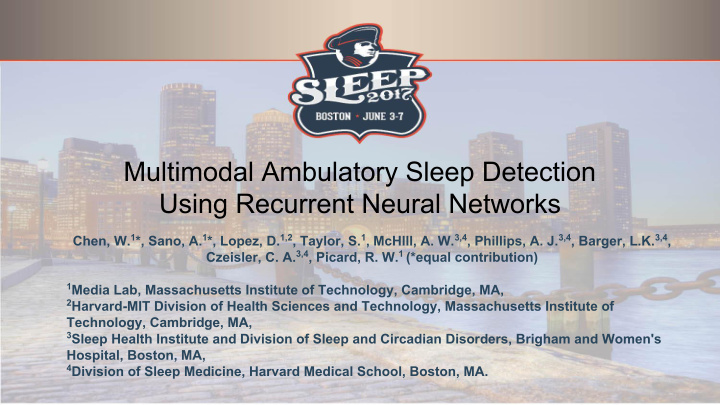



Multimodal Ambulatory Sleep Detection Using Recurrent Neural Networks Chen, W. 1 *, Sano, A. 1 *, Lopez, D. 1,2 , Taylor, S. 1 , McHlll, A. W. 3,4 , Phillips, A. J. 3,4 , Barger, L.K. 3,4 , Czeisler, C. A. 3,4 , Picard, R. W. 1 (*equal contribution) 1 Media Lab, Massachusetts Institute of Technology, Cambridge, MA, 2 Harvard-MIT Division of Health Sciences and Technology, Massachusetts Institute of Technology, Cambridge, MA, 3 Sleep Health Institute and Division of Sleep and Circadian Disorders, Brigham and Women's Hospital, Boston, MA, 4 Division of Sleep Medicine, Harvard Medical School, Boston, MA.
Conflict of Interest Disclosures for Speakers X 1. I do not have any relationships with any entities producing , marketing, re-selling, or distributing health care goods or services consumed by, or used on, patients, OR 2. I have the following relationships with entities producing , marketing, re-selling, or distributing health care goods or services consumed by, or used on, patients. Type of Potential Conflict Details of Potential Conflict Grant/Research Support Consultant Speakers’ Bureaus Financial support Other 3. The material presented in this lecture has no relationship with any of these potential conflicts, OR 4. This talk presents material that is related to one or more of these potential conflicts, and the following objective references are provided as support for this lecture: 1. 2. 3.
Motivation Polysomnography Actigraphy + Sleep (PSG) Diary + Impractical for Requires significant long-term home use effort of users to maintain accurate diaries, and of researchers to check the diary entries for anomalies There is a need for tools to enable accurate long-term evaluation of sleep timing and duration in daily life with less burden on users and researchers.
Data • 5580 days of multimodal data from a wrist sensor and an Android phone • 186 undergraduate students, 30 days each • Phone • Wrist Sensor Call Skin conductance (SC) SMS Acceleration (ACC) Location Skin temperature (ST) Screen • Time • Labels of sleep/wake: Human scored actigraphy with sleep diaries based on a previously established method (Barger et al., 2014) Resolution: 1 min -> 1 day = 1440 labels
Features SC is more likely to have periods of high frequency activity called “storms” during NREM2 and SWS sleep Movement index = (var(latitude) + var(longitude)) / 2
Methods Sleep detection: Bidirectional long short-term memory neural network model = Sleep Probability
Methods Sleep episode onset/offset detection: Bidirectional long short-term memory neural network model + Peak detection = Sleep Offset Probability
Results Sleep/wake classification accuracy: 96.5 % For each participant, ( Acceleration + Skin temperature + Time ) 80% of days - training set, 20% of days - test set Sleep episode onset detection F 1 scores: 0.86 , mean errors: 5.0 min Participant 1 Participant 2 Sleep episode offset detection F 1 scores: 0.84 , mean errors: 5.5 min
Generalized to different participants 80% of participants - training set 20% of participants - test set Participant 1 Participant 2
Real-time implementation
Conclusion We showed Sleep/wake classification accuracy: 96.5 % with features from Acceleration + Skin temperature + Time Sleep episode onset detection (F 1 scores: 0.86 , mean errors: 5.0 min) Sleep episode offset detection (F 1 scores: 0.84 , mean errors: 5.5 min) Our results indicate that long-term ambulatory sleep/wake records from large populations can be measured unobtrusively and accurately by exploiting the ubiquity of smartphones and wearable sensors and the power of deep learning.
Recommend
More recommend